Case Study: Auditing and Assurance of API (ACC568) Audit Memo
VerifiedAdded on 2023/03/17
|19
|4421
|24
Case Study
AI Summary
This case study presents an audit memo analyzing the financial statements of Always Precise Instruments Private Limited (API), a supplier of military equipment. The memo, written from the perspective of an audit manager, addresses key aspects of the audit, including ratio analysis to identify potential audit risks, such as those related to current and quick ratios, return on equity, and gross margin. It also identifies internal control weaknesses within API's inventory system, outlining potential audit risks and proposing appropriate audit procedures. Furthermore, the memo examines specific audit assertions and recommends suitable sampling procedures, providing justifications for each. The analysis covers various financial ratios, including current ratio, quick asset ratio, return on equity, return on total assets, gross margin, marketing expense, administrative expenses, times earned interest, days in inventory, days in accounts receivable, and debt to equity ratio. For each ratio, the memo identifies potential audit risks and suggests corresponding audit procedures. The memo also details internal control weaknesses, potential audit risks, and suggested audit procedures related to authorization of purchase orders and production orders. This case study provides a comprehensive overview of the auditing process and helps in understanding the various aspects of an audit.
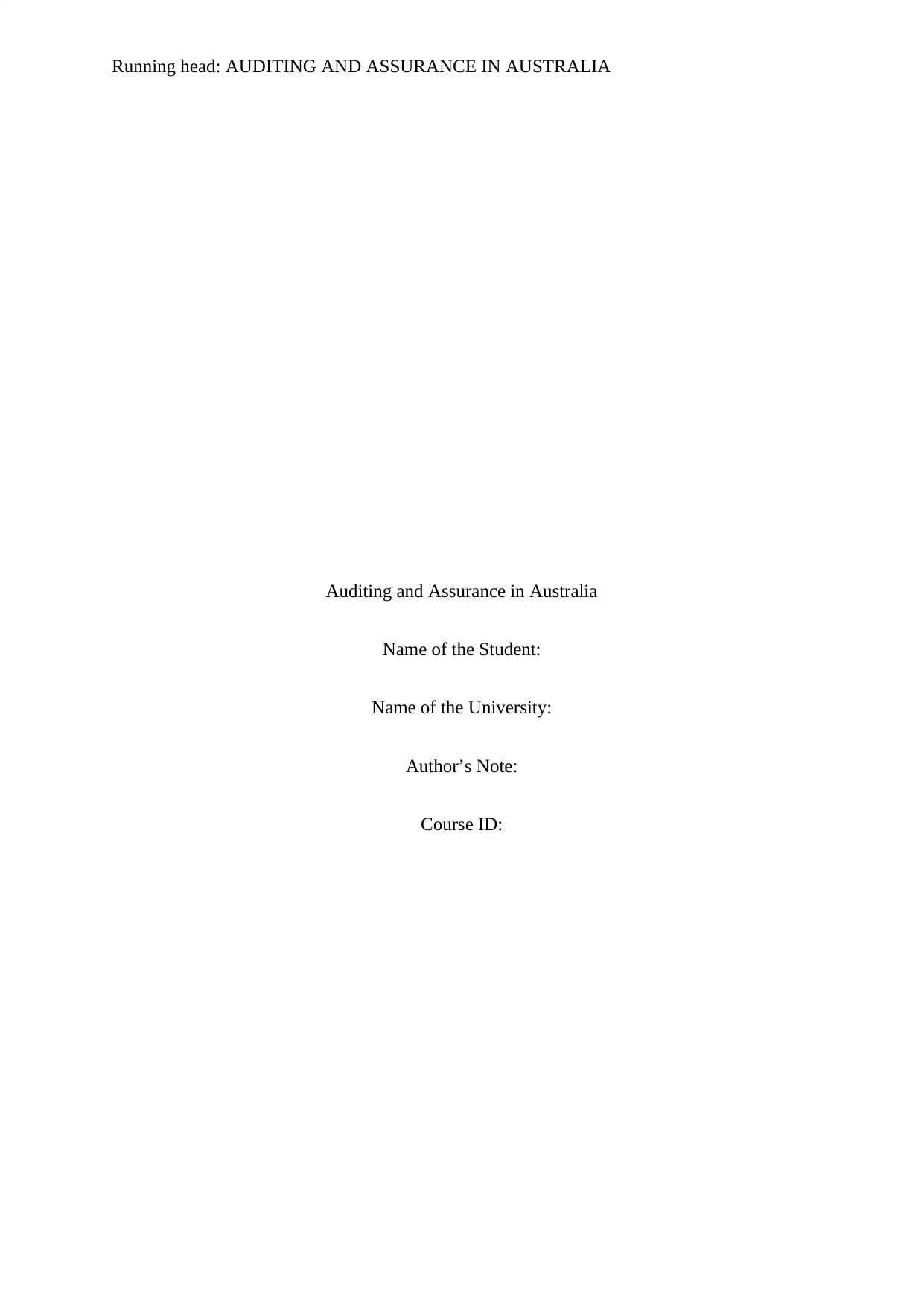
Running head: AUDITING AND ASSURANCE IN AUSTRALIA
Auditing and Assurance in Australia
Name of the Student:
Name of the University:
Author’s Note:
Course ID:
Auditing and Assurance in Australia
Name of the Student:
Name of the University:
Author’s Note:
Course ID:
Paraphrase This Document
Need a fresh take? Get an instant paraphrase of this document with our AI Paraphraser
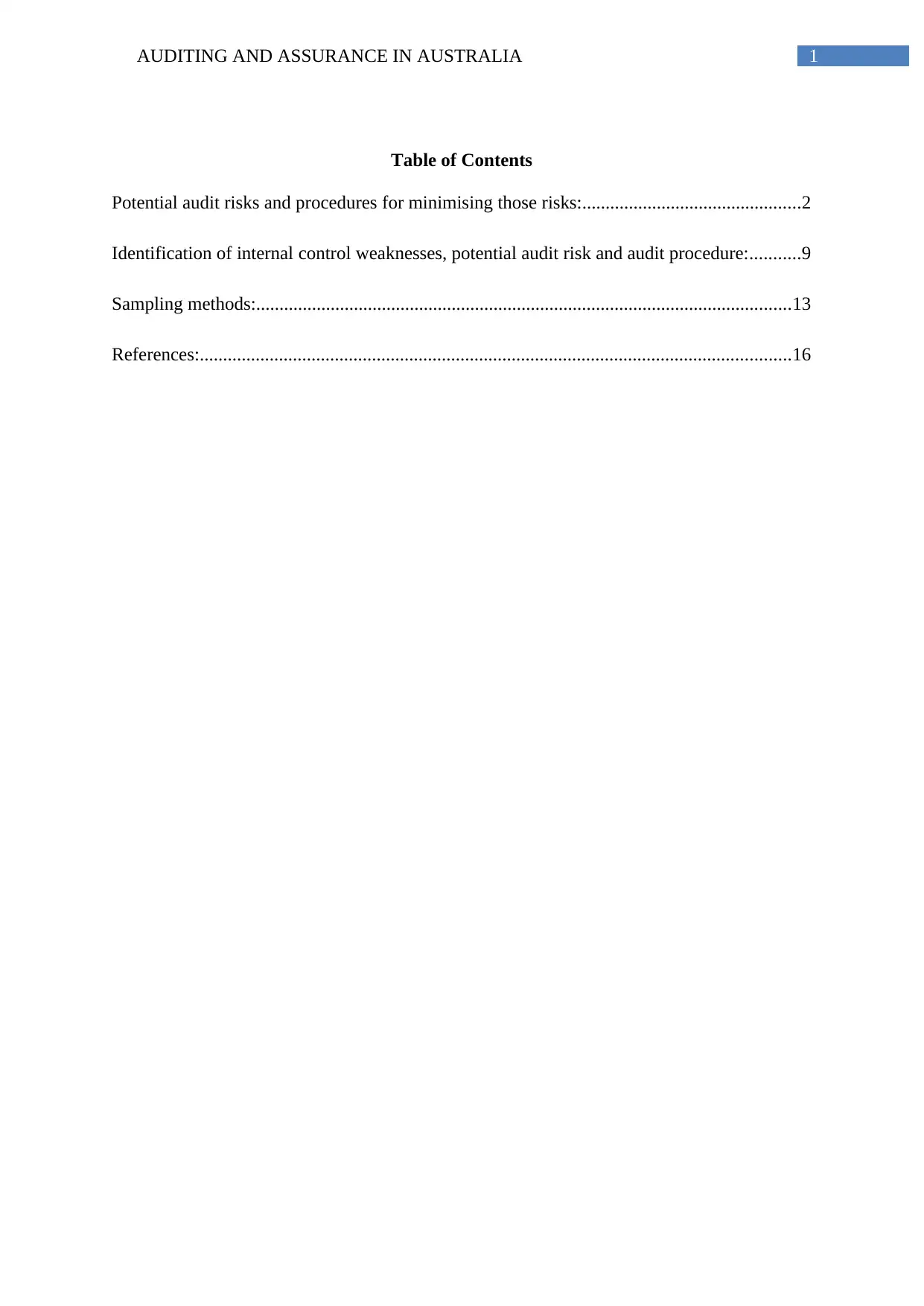
1AUDITING AND ASSURANCE IN AUSTRALIA
Table of Contents
Potential audit risks and procedures for minimising those risks:...............................................2
Identification of internal control weaknesses, potential audit risk and audit procedure:...........9
Sampling methods:...................................................................................................................13
References:...............................................................................................................................16
Table of Contents
Potential audit risks and procedures for minimising those risks:...............................................2
Identification of internal control weaknesses, potential audit risk and audit procedure:...........9
Sampling methods:...................................................................................................................13
References:...............................................................................................................................16

2AUDITING AND ASSURANCE IN AUSTRALIA
Memo
To: Wayne Wiadrowski
From: The Audit Manager
Date: 09/05/2019
Subject: Significant aspects under consideration for conducting the audit of API
In order to carry out audit operations, the auditors are required to take into account all
the crucial aspects, which are deemed to be necessary. These mainly include critical analysis
of different line items in the disclosed financial statements of an organisation and the internal
control systems in place. The memo is prepared for addressing those areas having concern in
internal control and financial statements of Always Precise Instruments Private Limited
(API). The organisation is a supplier and producer of small arms military equipment. There
are three particular aspects that have been addressed in this memo. Firstly, evaluation of the
provided ratios is made for detecting the potential risks in order to outline sound auditing
procedures. Secondly, the weaknesses in internal control of API are identified for the
inventory system in order to find out the potential audit risks and accordingly, appropriate
audit procedures could be developed. Finally, it considers the analysis of two particular audit
assertions as well as suitable sampling procedures by providing adequate justifications for the
same.
Potential audit risks and procedures for minimising those risks:
Ratio Analysis Audit Risk Audit Procedures
Current ratio It could be seen that
API has experienced an
increase in this ratio,
This rise in current
ratio is subject to audit
risk, as the current
In this case, the necessary audit
procedure would be to
investigate the liquidity position
Memo
To: Wayne Wiadrowski
From: The Audit Manager
Date: 09/05/2019
Subject: Significant aspects under consideration for conducting the audit of API
In order to carry out audit operations, the auditors are required to take into account all
the crucial aspects, which are deemed to be necessary. These mainly include critical analysis
of different line items in the disclosed financial statements of an organisation and the internal
control systems in place. The memo is prepared for addressing those areas having concern in
internal control and financial statements of Always Precise Instruments Private Limited
(API). The organisation is a supplier and producer of small arms military equipment. There
are three particular aspects that have been addressed in this memo. Firstly, evaluation of the
provided ratios is made for detecting the potential risks in order to outline sound auditing
procedures. Secondly, the weaknesses in internal control of API are identified for the
inventory system in order to find out the potential audit risks and accordingly, appropriate
audit procedures could be developed. Finally, it considers the analysis of two particular audit
assertions as well as suitable sampling procedures by providing adequate justifications for the
same.
Potential audit risks and procedures for minimising those risks:
Ratio Analysis Audit Risk Audit Procedures
Current ratio It could be seen that
API has experienced an
increase in this ratio,
This rise in current
ratio is subject to audit
risk, as the current
In this case, the necessary audit
procedure would be to
investigate the liquidity position
⊘ This is a preview!⊘
Do you want full access?
Subscribe today to unlock all pages.

Trusted by 1+ million students worldwide
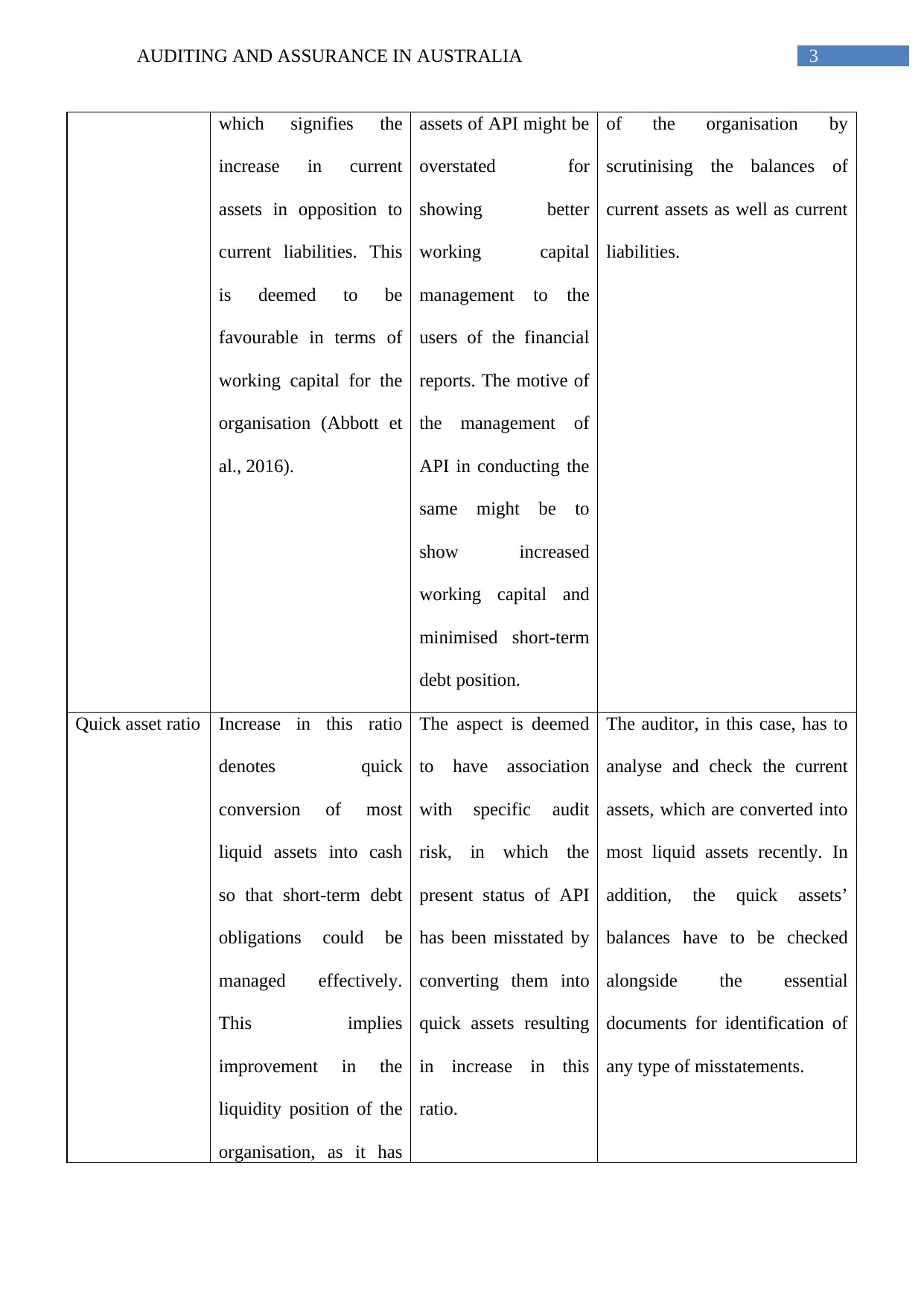
3AUDITING AND ASSURANCE IN AUSTRALIA
which signifies the
increase in current
assets in opposition to
current liabilities. This
is deemed to be
favourable in terms of
working capital for the
organisation (Abbott et
al., 2016).
assets of API might be
overstated for
showing better
working capital
management to the
users of the financial
reports. The motive of
the management of
API in conducting the
same might be to
show increased
working capital and
minimised short-term
debt position.
of the organisation by
scrutinising the balances of
current assets as well as current
liabilities.
Quick asset ratio Increase in this ratio
denotes quick
conversion of most
liquid assets into cash
so that short-term debt
obligations could be
managed effectively.
This implies
improvement in the
liquidity position of the
organisation, as it has
The aspect is deemed
to have association
with specific audit
risk, in which the
present status of API
has been misstated by
converting them into
quick assets resulting
in increase in this
ratio.
The auditor, in this case, has to
analyse and check the current
assets, which are converted into
most liquid assets recently. In
addition, the quick assets’
balances have to be checked
alongside the essential
documents for identification of
any type of misstatements.
which signifies the
increase in current
assets in opposition to
current liabilities. This
is deemed to be
favourable in terms of
working capital for the
organisation (Abbott et
al., 2016).
assets of API might be
overstated for
showing better
working capital
management to the
users of the financial
reports. The motive of
the management of
API in conducting the
same might be to
show increased
working capital and
minimised short-term
debt position.
of the organisation by
scrutinising the balances of
current assets as well as current
liabilities.
Quick asset ratio Increase in this ratio
denotes quick
conversion of most
liquid assets into cash
so that short-term debt
obligations could be
managed effectively.
This implies
improvement in the
liquidity position of the
organisation, as it has
The aspect is deemed
to have association
with specific audit
risk, in which the
present status of API
has been misstated by
converting them into
quick assets resulting
in increase in this
ratio.
The auditor, in this case, has to
analyse and check the current
assets, which are converted into
most liquid assets recently. In
addition, the quick assets’
balances have to be checked
alongside the essential
documents for identification of
any type of misstatements.
Paraphrase This Document
Need a fresh take? Get an instant paraphrase of this document with our AI Paraphraser
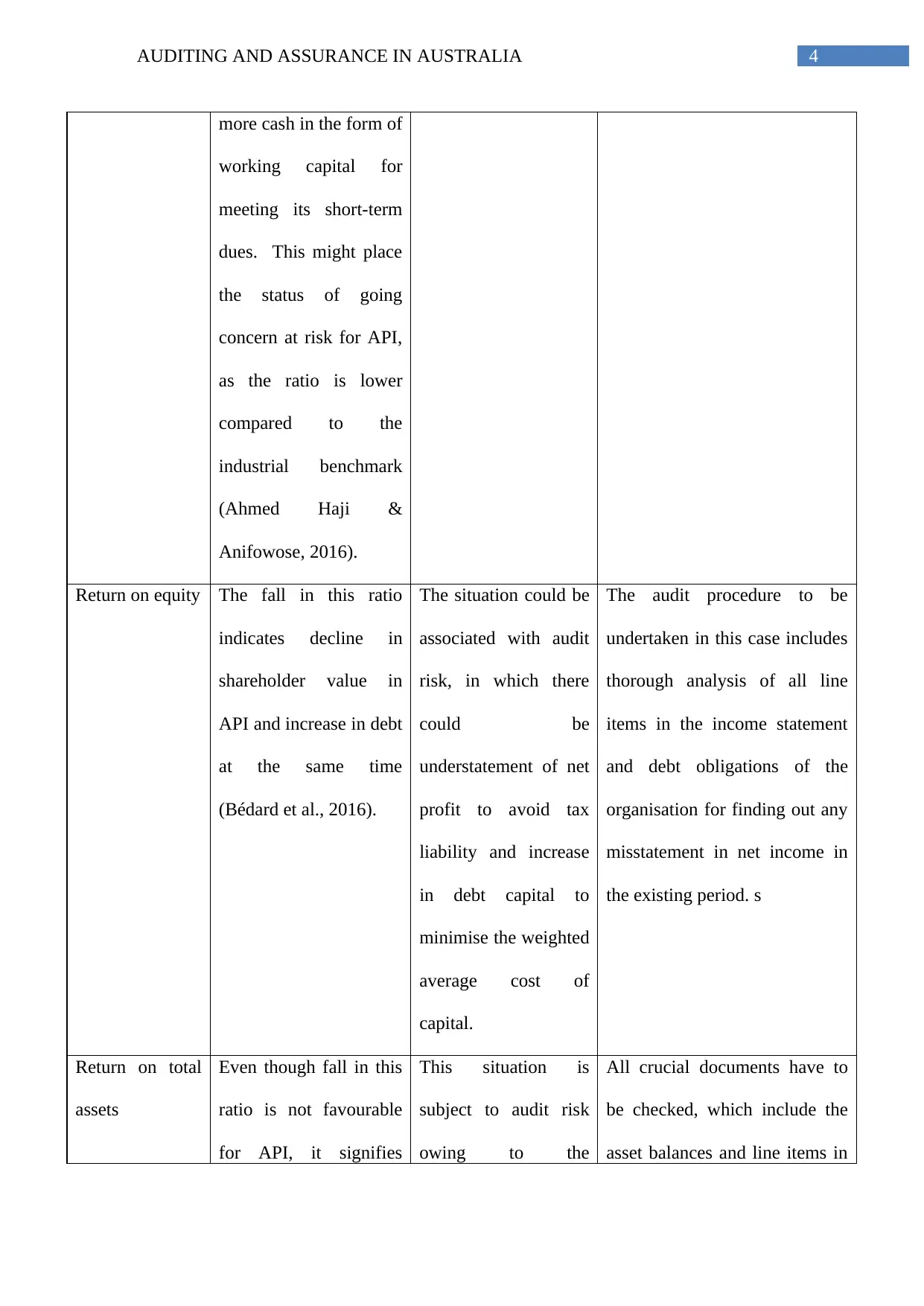
4AUDITING AND ASSURANCE IN AUSTRALIA
more cash in the form of
working capital for
meeting its short-term
dues. This might place
the status of going
concern at risk for API,
as the ratio is lower
compared to the
industrial benchmark
(Ahmed Haji &
Anifowose, 2016).
Return on equity The fall in this ratio
indicates decline in
shareholder value in
API and increase in debt
at the same time
(Bédard et al., 2016).
The situation could be
associated with audit
risk, in which there
could be
understatement of net
profit to avoid tax
liability and increase
in debt capital to
minimise the weighted
average cost of
capital.
The audit procedure to be
undertaken in this case includes
thorough analysis of all line
items in the income statement
and debt obligations of the
organisation for finding out any
misstatement in net income in
the existing period. s
Return on total
assets
Even though fall in this
ratio is not favourable
for API, it signifies
This situation is
subject to audit risk
owing to the
All crucial documents have to
be checked, which include the
asset balances and line items in
more cash in the form of
working capital for
meeting its short-term
dues. This might place
the status of going
concern at risk for API,
as the ratio is lower
compared to the
industrial benchmark
(Ahmed Haji &
Anifowose, 2016).
Return on equity The fall in this ratio
indicates decline in
shareholder value in
API and increase in debt
at the same time
(Bédard et al., 2016).
The situation could be
associated with audit
risk, in which there
could be
understatement of net
profit to avoid tax
liability and increase
in debt capital to
minimise the weighted
average cost of
capital.
The audit procedure to be
undertaken in this case includes
thorough analysis of all line
items in the income statement
and debt obligations of the
organisation for finding out any
misstatement in net income in
the existing period. s
Return on total
assets
Even though fall in this
ratio is not favourable
for API, it signifies
This situation is
subject to audit risk
owing to the
All crucial documents have to
be checked, which include the
asset balances and line items in
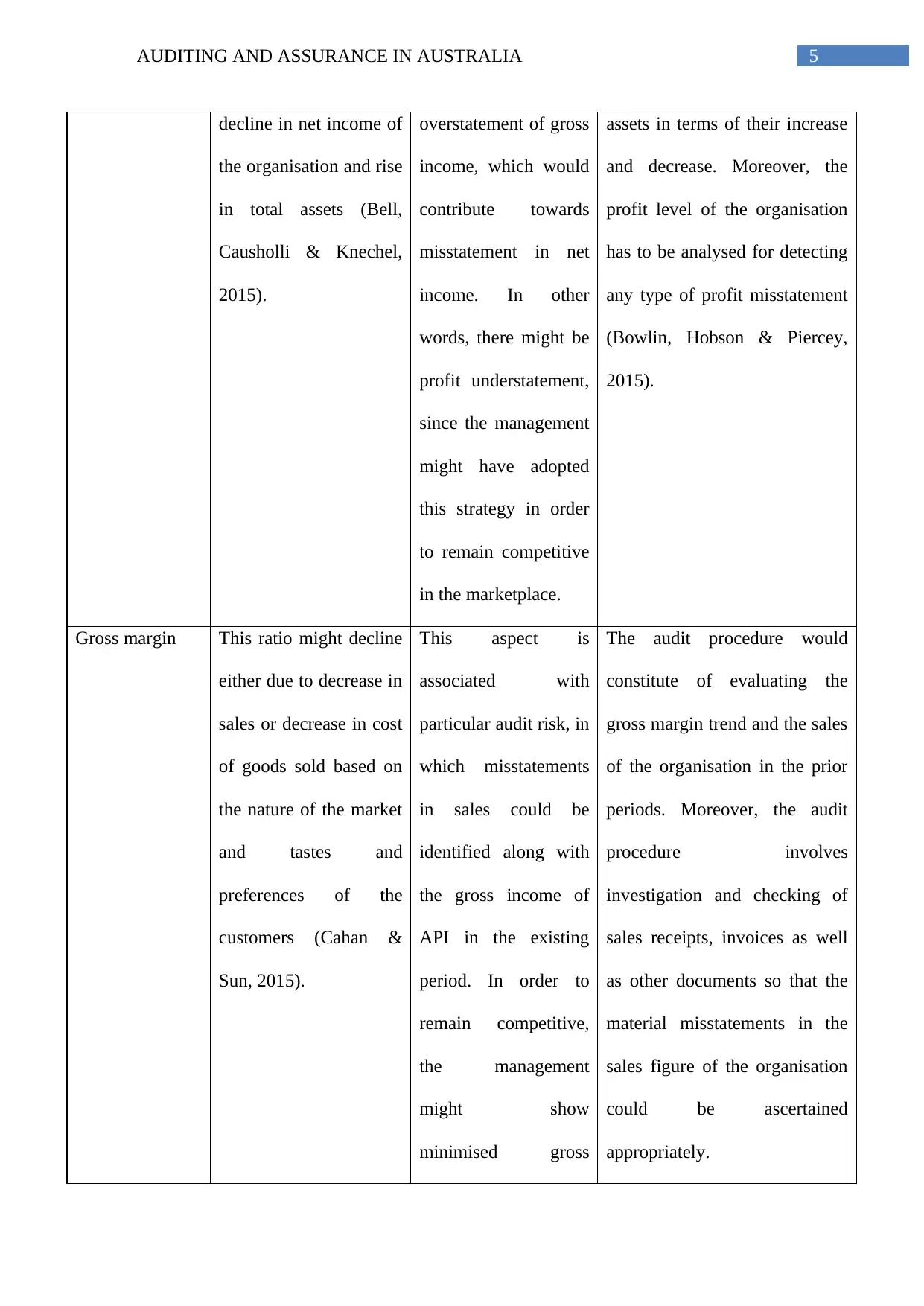
5AUDITING AND ASSURANCE IN AUSTRALIA
decline in net income of
the organisation and rise
in total assets (Bell,
Causholli & Knechel,
2015).
overstatement of gross
income, which would
contribute towards
misstatement in net
income. In other
words, there might be
profit understatement,
since the management
might have adopted
this strategy in order
to remain competitive
in the marketplace.
assets in terms of their increase
and decrease. Moreover, the
profit level of the organisation
has to be analysed for detecting
any type of profit misstatement
(Bowlin, Hobson & Piercey,
2015).
Gross margin This ratio might decline
either due to decrease in
sales or decrease in cost
of goods sold based on
the nature of the market
and tastes and
preferences of the
customers (Cahan &
Sun, 2015).
This aspect is
associated with
particular audit risk, in
which misstatements
in sales could be
identified along with
the gross income of
API in the existing
period. In order to
remain competitive,
the management
might show
minimised gross
The audit procedure would
constitute of evaluating the
gross margin trend and the sales
of the organisation in the prior
periods. Moreover, the audit
procedure involves
investigation and checking of
sales receipts, invoices as well
as other documents so that the
material misstatements in the
sales figure of the organisation
could be ascertained
appropriately.
decline in net income of
the organisation and rise
in total assets (Bell,
Causholli & Knechel,
2015).
overstatement of gross
income, which would
contribute towards
misstatement in net
income. In other
words, there might be
profit understatement,
since the management
might have adopted
this strategy in order
to remain competitive
in the marketplace.
assets in terms of their increase
and decrease. Moreover, the
profit level of the organisation
has to be analysed for detecting
any type of profit misstatement
(Bowlin, Hobson & Piercey,
2015).
Gross margin This ratio might decline
either due to decrease in
sales or decrease in cost
of goods sold based on
the nature of the market
and tastes and
preferences of the
customers (Cahan &
Sun, 2015).
This aspect is
associated with
particular audit risk, in
which misstatements
in sales could be
identified along with
the gross income of
API in the existing
period. In order to
remain competitive,
the management
might show
minimised gross
The audit procedure would
constitute of evaluating the
gross margin trend and the sales
of the organisation in the prior
periods. Moreover, the audit
procedure involves
investigation and checking of
sales receipts, invoices as well
as other documents so that the
material misstatements in the
sales figure of the organisation
could be ascertained
appropriately.
⊘ This is a preview!⊘
Do you want full access?
Subscribe today to unlock all pages.

Trusted by 1+ million students worldwide
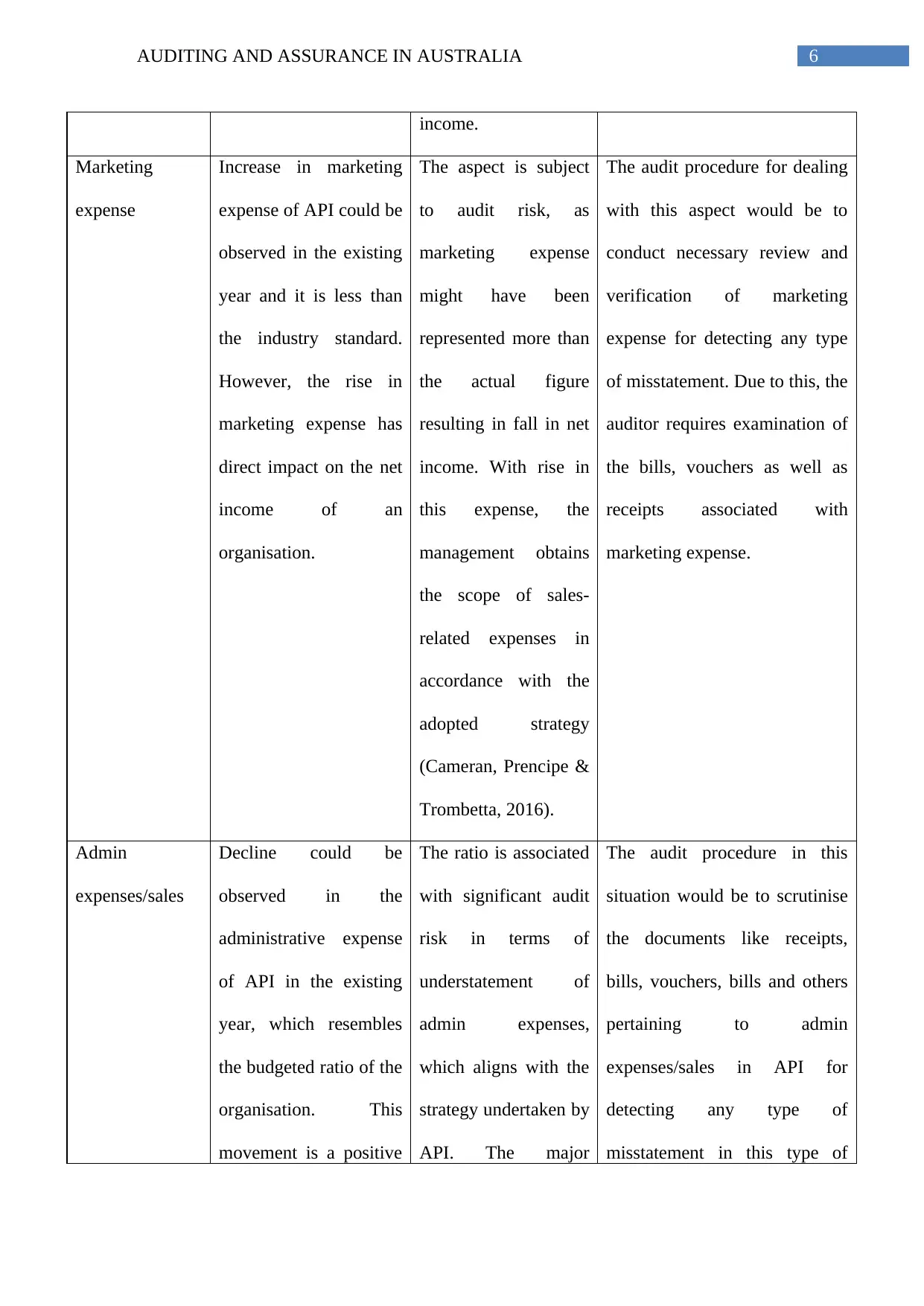
6AUDITING AND ASSURANCE IN AUSTRALIA
income.
Marketing
expense
Increase in marketing
expense of API could be
observed in the existing
year and it is less than
the industry standard.
However, the rise in
marketing expense has
direct impact on the net
income of an
organisation.
The aspect is subject
to audit risk, as
marketing expense
might have been
represented more than
the actual figure
resulting in fall in net
income. With rise in
this expense, the
management obtains
the scope of sales-
related expenses in
accordance with the
adopted strategy
(Cameran, Prencipe &
Trombetta, 2016).
The audit procedure for dealing
with this aspect would be to
conduct necessary review and
verification of marketing
expense for detecting any type
of misstatement. Due to this, the
auditor requires examination of
the bills, vouchers as well as
receipts associated with
marketing expense.
Admin
expenses/sales
Decline could be
observed in the
administrative expense
of API in the existing
year, which resembles
the budgeted ratio of the
organisation. This
movement is a positive
The ratio is associated
with significant audit
risk in terms of
understatement of
admin expenses,
which aligns with the
strategy undertaken by
API. The major
The audit procedure in this
situation would be to scrutinise
the documents like receipts,
bills, vouchers, bills and others
pertaining to admin
expenses/sales in API for
detecting any type of
misstatement in this type of
income.
Marketing
expense
Increase in marketing
expense of API could be
observed in the existing
year and it is less than
the industry standard.
However, the rise in
marketing expense has
direct impact on the net
income of an
organisation.
The aspect is subject
to audit risk, as
marketing expense
might have been
represented more than
the actual figure
resulting in fall in net
income. With rise in
this expense, the
management obtains
the scope of sales-
related expenses in
accordance with the
adopted strategy
(Cameran, Prencipe &
Trombetta, 2016).
The audit procedure for dealing
with this aspect would be to
conduct necessary review and
verification of marketing
expense for detecting any type
of misstatement. Due to this, the
auditor requires examination of
the bills, vouchers as well as
receipts associated with
marketing expense.
Admin
expenses/sales
Decline could be
observed in the
administrative expense
of API in the existing
year, which resembles
the budgeted ratio of the
organisation. This
movement is a positive
The ratio is associated
with significant audit
risk in terms of
understatement of
admin expenses,
which aligns with the
strategy undertaken by
API. The major
The audit procedure in this
situation would be to scrutinise
the documents like receipts,
bills, vouchers, bills and others
pertaining to admin
expenses/sales in API for
detecting any type of
misstatement in this type of
Paraphrase This Document
Need a fresh take? Get an instant paraphrase of this document with our AI Paraphraser

7AUDITING AND ASSURANCE IN AUSTRALIA
sign in terms of
business profitability for
API.
incentive behind the
management of the
organisation might be
the strategy of cost
minimisation,
particularly selling
expenses (Campa and
Donnelly 2016).
expense in the organisation.
Times interest
earned
Decline in this specific
ratio indicates that API
might not have
sufficient earnings in
order to make interest
payments. The fall in
long-term amount debt
could be the significant
reason for the
organisation.
This risk is associated
with the potential
audit risk of earnings
manipulation from the
end of the
management, which
has minimised the
ability of API to incur
interest. There is
understatement risk in
the debt position of
API as a part of the
existing strategy of the
organisation
(Causholli, Chambers
& Payne, 2014).
In this condition, the audit
procedure would incorporate
the investigation as well as
invigilation of API earnings for
identification of manipulation.
In addition, the auditor has to
review the debt position of the
organisation for determining
any type of material
misstatements in the same
(Chambers & Odar, 2015).
Days in Rise in days in This specific situation In this case, the important audit
sign in terms of
business profitability for
API.
incentive behind the
management of the
organisation might be
the strategy of cost
minimisation,
particularly selling
expenses (Campa and
Donnelly 2016).
expense in the organisation.
Times interest
earned
Decline in this specific
ratio indicates that API
might not have
sufficient earnings in
order to make interest
payments. The fall in
long-term amount debt
could be the significant
reason for the
organisation.
This risk is associated
with the potential
audit risk of earnings
manipulation from the
end of the
management, which
has minimised the
ability of API to incur
interest. There is
understatement risk in
the debt position of
API as a part of the
existing strategy of the
organisation
(Causholli, Chambers
& Payne, 2014).
In this condition, the audit
procedure would incorporate
the investigation as well as
invigilation of API earnings for
identification of manipulation.
In addition, the auditor has to
review the debt position of the
organisation for determining
any type of material
misstatements in the same
(Chambers & Odar, 2015).
Days in Rise in days in This specific situation In this case, the important audit
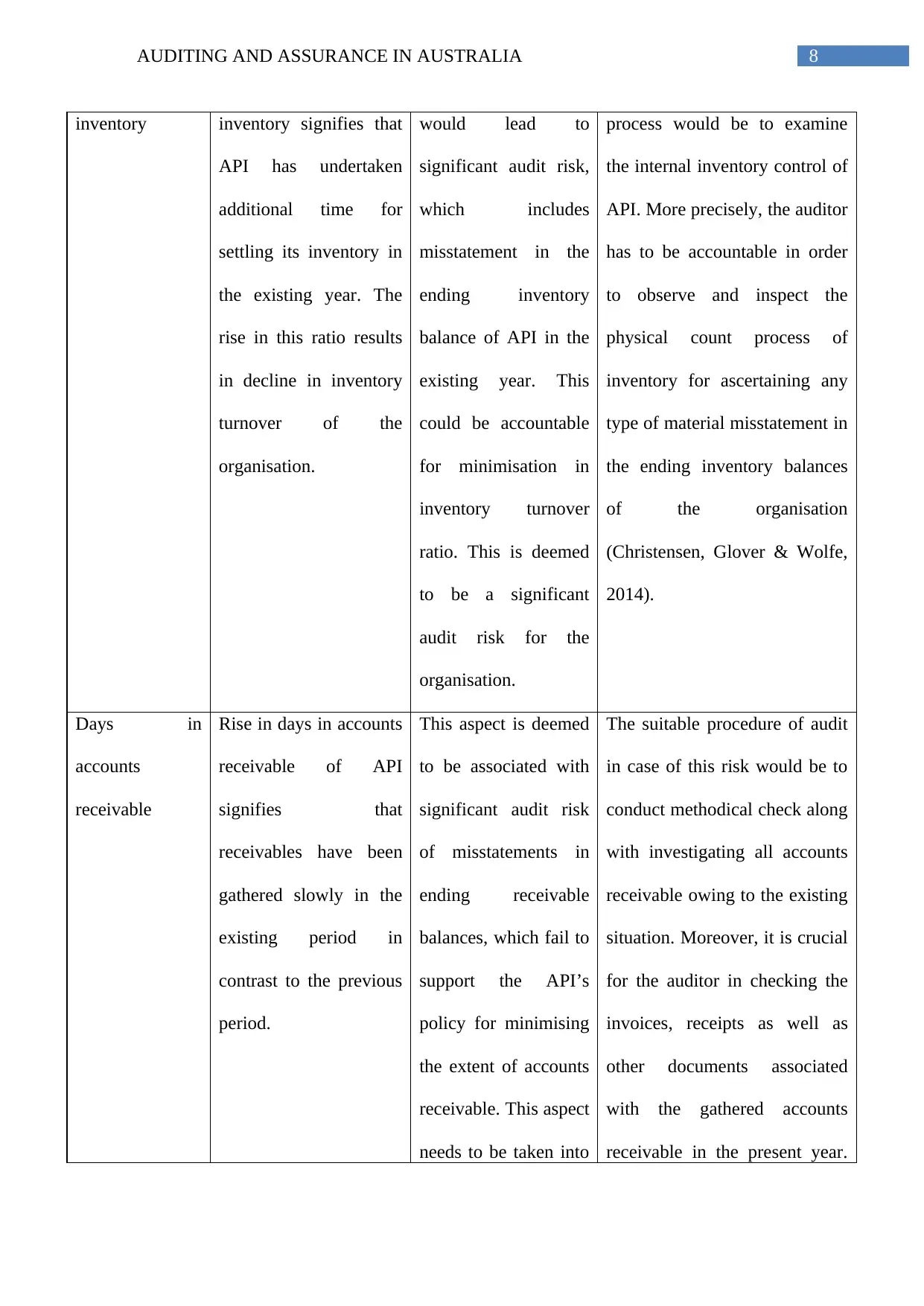
8AUDITING AND ASSURANCE IN AUSTRALIA
inventory inventory signifies that
API has undertaken
additional time for
settling its inventory in
the existing year. The
rise in this ratio results
in decline in inventory
turnover of the
organisation.
would lead to
significant audit risk,
which includes
misstatement in the
ending inventory
balance of API in the
existing year. This
could be accountable
for minimisation in
inventory turnover
ratio. This is deemed
to be a significant
audit risk for the
organisation.
process would be to examine
the internal inventory control of
API. More precisely, the auditor
has to be accountable in order
to observe and inspect the
physical count process of
inventory for ascertaining any
type of material misstatement in
the ending inventory balances
of the organisation
(Christensen, Glover & Wolfe,
2014).
Days in
accounts
receivable
Rise in days in accounts
receivable of API
signifies that
receivables have been
gathered slowly in the
existing period in
contrast to the previous
period.
This aspect is deemed
to be associated with
significant audit risk
of misstatements in
ending receivable
balances, which fail to
support the API’s
policy for minimising
the extent of accounts
receivable. This aspect
needs to be taken into
The suitable procedure of audit
in case of this risk would be to
conduct methodical check along
with investigating all accounts
receivable owing to the existing
situation. Moreover, it is crucial
for the auditor in checking the
invoices, receipts as well as
other documents associated
with the gathered accounts
receivable in the present year.
inventory inventory signifies that
API has undertaken
additional time for
settling its inventory in
the existing year. The
rise in this ratio results
in decline in inventory
turnover of the
organisation.
would lead to
significant audit risk,
which includes
misstatement in the
ending inventory
balance of API in the
existing year. This
could be accountable
for minimisation in
inventory turnover
ratio. This is deemed
to be a significant
audit risk for the
organisation.
process would be to examine
the internal inventory control of
API. More precisely, the auditor
has to be accountable in order
to observe and inspect the
physical count process of
inventory for ascertaining any
type of material misstatement in
the ending inventory balances
of the organisation
(Christensen, Glover & Wolfe,
2014).
Days in
accounts
receivable
Rise in days in accounts
receivable of API
signifies that
receivables have been
gathered slowly in the
existing period in
contrast to the previous
period.
This aspect is deemed
to be associated with
significant audit risk
of misstatements in
ending receivable
balances, which fail to
support the API’s
policy for minimising
the extent of accounts
receivable. This aspect
needs to be taken into
The suitable procedure of audit
in case of this risk would be to
conduct methodical check along
with investigating all accounts
receivable owing to the existing
situation. Moreover, it is crucial
for the auditor in checking the
invoices, receipts as well as
other documents associated
with the gathered accounts
receivable in the present year.
⊘ This is a preview!⊘
Do you want full access?
Subscribe today to unlock all pages.

Trusted by 1+ million students worldwide
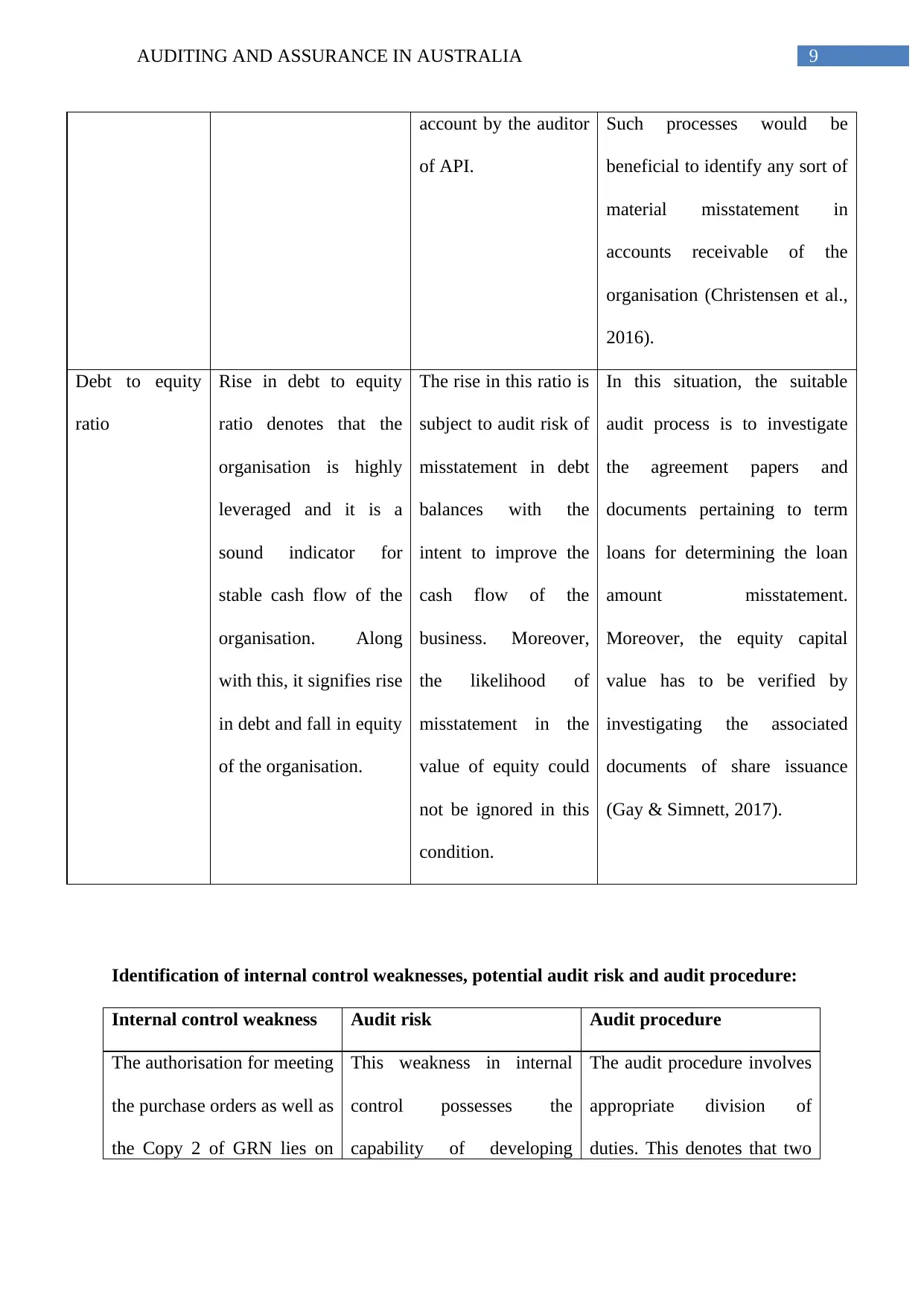
9AUDITING AND ASSURANCE IN AUSTRALIA
account by the auditor
of API.
Such processes would be
beneficial to identify any sort of
material misstatement in
accounts receivable of the
organisation (Christensen et al.,
2016).
Debt to equity
ratio
Rise in debt to equity
ratio denotes that the
organisation is highly
leveraged and it is a
sound indicator for
stable cash flow of the
organisation. Along
with this, it signifies rise
in debt and fall in equity
of the organisation.
The rise in this ratio is
subject to audit risk of
misstatement in debt
balances with the
intent to improve the
cash flow of the
business. Moreover,
the likelihood of
misstatement in the
value of equity could
not be ignored in this
condition.
In this situation, the suitable
audit process is to investigate
the agreement papers and
documents pertaining to term
loans for determining the loan
amount misstatement.
Moreover, the equity capital
value has to be verified by
investigating the associated
documents of share issuance
(Gay & Simnett, 2017).
Identification of internal control weaknesses, potential audit risk and audit procedure:
Internal control weakness Audit risk Audit procedure
The authorisation for meeting
the purchase orders as well as
the Copy 2 of GRN lies on
This weakness in internal
control possesses the
capability of developing
The audit procedure involves
appropriate division of
duties. This denotes that two
account by the auditor
of API.
Such processes would be
beneficial to identify any sort of
material misstatement in
accounts receivable of the
organisation (Christensen et al.,
2016).
Debt to equity
ratio
Rise in debt to equity
ratio denotes that the
organisation is highly
leveraged and it is a
sound indicator for
stable cash flow of the
organisation. Along
with this, it signifies rise
in debt and fall in equity
of the organisation.
The rise in this ratio is
subject to audit risk of
misstatement in debt
balances with the
intent to improve the
cash flow of the
business. Moreover,
the likelihood of
misstatement in the
value of equity could
not be ignored in this
condition.
In this situation, the suitable
audit process is to investigate
the agreement papers and
documents pertaining to term
loans for determining the loan
amount misstatement.
Moreover, the equity capital
value has to be verified by
investigating the associated
documents of share issuance
(Gay & Simnett, 2017).
Identification of internal control weaknesses, potential audit risk and audit procedure:
Internal control weakness Audit risk Audit procedure
The authorisation for meeting
the purchase orders as well as
the Copy 2 of GRN lies on
This weakness in internal
control possesses the
capability of developing
The audit procedure involves
appropriate division of
duties. This denotes that two
Paraphrase This Document
Need a fresh take? Get an instant paraphrase of this document with our AI Paraphraser
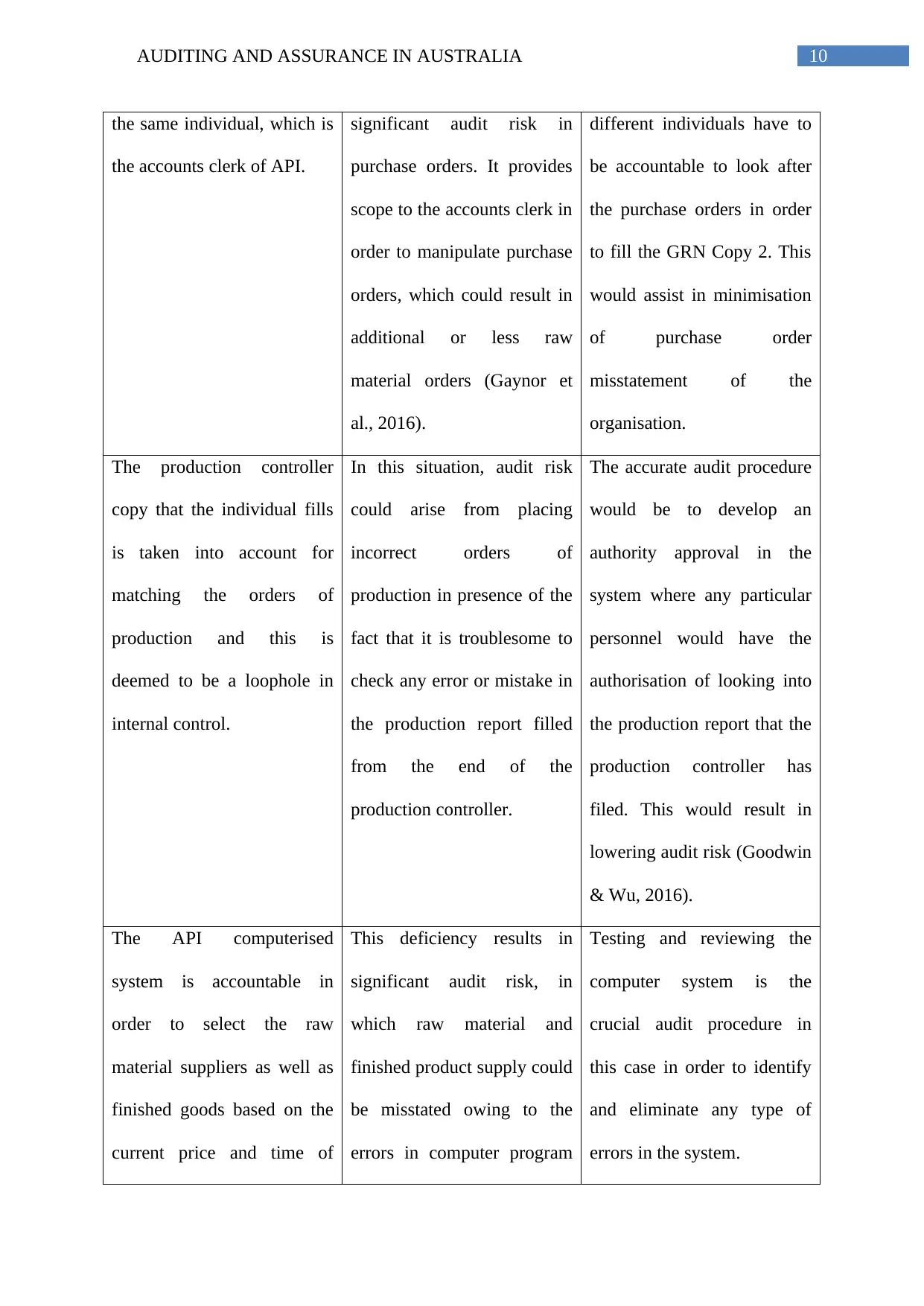
10AUDITING AND ASSURANCE IN AUSTRALIA
the same individual, which is
the accounts clerk of API.
significant audit risk in
purchase orders. It provides
scope to the accounts clerk in
order to manipulate purchase
orders, which could result in
additional or less raw
material orders (Gaynor et
al., 2016).
different individuals have to
be accountable to look after
the purchase orders in order
to fill the GRN Copy 2. This
would assist in minimisation
of purchase order
misstatement of the
organisation.
The production controller
copy that the individual fills
is taken into account for
matching the orders of
production and this is
deemed to be a loophole in
internal control.
In this situation, audit risk
could arise from placing
incorrect orders of
production in presence of the
fact that it is troublesome to
check any error or mistake in
the production report filled
from the end of the
production controller.
The accurate audit procedure
would be to develop an
authority approval in the
system where any particular
personnel would have the
authorisation of looking into
the production report that the
production controller has
filed. This would result in
lowering audit risk (Goodwin
& Wu, 2016).
The API computerised
system is accountable in
order to select the raw
material suppliers as well as
finished goods based on the
current price and time of
This deficiency results in
significant audit risk, in
which raw material and
finished product supply could
be misstated owing to the
errors in computer program
Testing and reviewing the
computer system is the
crucial audit procedure in
this case in order to identify
and eliminate any type of
errors in the system.
the same individual, which is
the accounts clerk of API.
significant audit risk in
purchase orders. It provides
scope to the accounts clerk in
order to manipulate purchase
orders, which could result in
additional or less raw
material orders (Gaynor et
al., 2016).
different individuals have to
be accountable to look after
the purchase orders in order
to fill the GRN Copy 2. This
would assist in minimisation
of purchase order
misstatement of the
organisation.
The production controller
copy that the individual fills
is taken into account for
matching the orders of
production and this is
deemed to be a loophole in
internal control.
In this situation, audit risk
could arise from placing
incorrect orders of
production in presence of the
fact that it is troublesome to
check any error or mistake in
the production report filled
from the end of the
production controller.
The accurate audit procedure
would be to develop an
authority approval in the
system where any particular
personnel would have the
authorisation of looking into
the production report that the
production controller has
filed. This would result in
lowering audit risk (Goodwin
& Wu, 2016).
The API computerised
system is accountable in
order to select the raw
material suppliers as well as
finished goods based on the
current price and time of
This deficiency results in
significant audit risk, in
which raw material and
finished product supply could
be misstated owing to the
errors in computer program
Testing and reviewing the
computer system is the
crucial audit procedure in
this case in order to identify
and eliminate any type of
errors in the system.
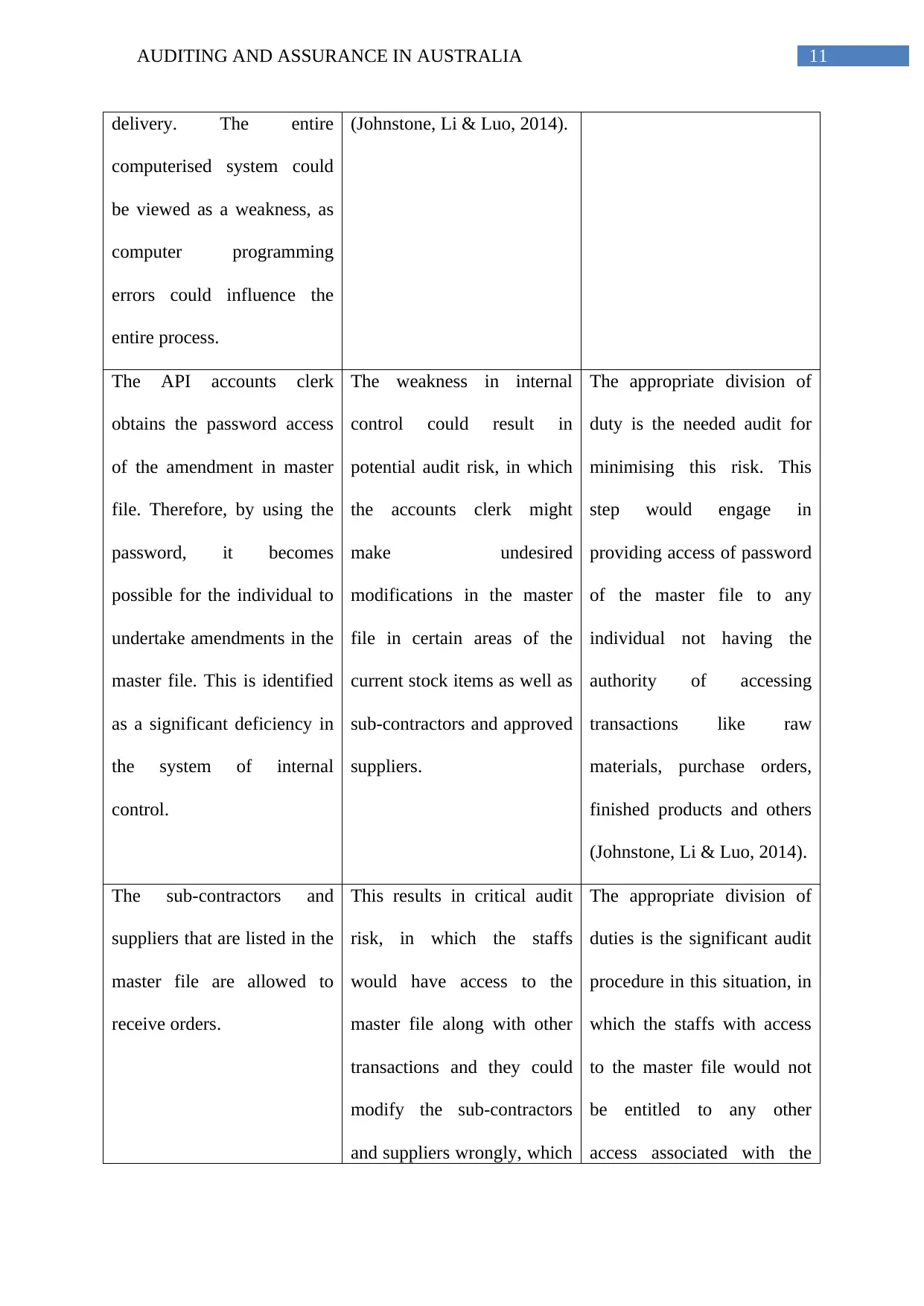
11AUDITING AND ASSURANCE IN AUSTRALIA
delivery. The entire
computerised system could
be viewed as a weakness, as
computer programming
errors could influence the
entire process.
(Johnstone, Li & Luo, 2014).
The API accounts clerk
obtains the password access
of the amendment in master
file. Therefore, by using the
password, it becomes
possible for the individual to
undertake amendments in the
master file. This is identified
as a significant deficiency in
the system of internal
control.
The weakness in internal
control could result in
potential audit risk, in which
the accounts clerk might
make undesired
modifications in the master
file in certain areas of the
current stock items as well as
sub-contractors and approved
suppliers.
The appropriate division of
duty is the needed audit for
minimising this risk. This
step would engage in
providing access of password
of the master file to any
individual not having the
authority of accessing
transactions like raw
materials, purchase orders,
finished products and others
(Johnstone, Li & Luo, 2014).
The sub-contractors and
suppliers that are listed in the
master file are allowed to
receive orders.
This results in critical audit
risk, in which the staffs
would have access to the
master file along with other
transactions and they could
modify the sub-contractors
and suppliers wrongly, which
The appropriate division of
duties is the significant audit
procedure in this situation, in
which the staffs with access
to the master file would not
be entitled to any other
access associated with the
delivery. The entire
computerised system could
be viewed as a weakness, as
computer programming
errors could influence the
entire process.
(Johnstone, Li & Luo, 2014).
The API accounts clerk
obtains the password access
of the amendment in master
file. Therefore, by using the
password, it becomes
possible for the individual to
undertake amendments in the
master file. This is identified
as a significant deficiency in
the system of internal
control.
The weakness in internal
control could result in
potential audit risk, in which
the accounts clerk might
make undesired
modifications in the master
file in certain areas of the
current stock items as well as
sub-contractors and approved
suppliers.
The appropriate division of
duty is the needed audit for
minimising this risk. This
step would engage in
providing access of password
of the master file to any
individual not having the
authority of accessing
transactions like raw
materials, purchase orders,
finished products and others
(Johnstone, Li & Luo, 2014).
The sub-contractors and
suppliers that are listed in the
master file are allowed to
receive orders.
This results in critical audit
risk, in which the staffs
would have access to the
master file along with other
transactions and they could
modify the sub-contractors
and suppliers wrongly, which
The appropriate division of
duties is the significant audit
procedure in this situation, in
which the staffs with access
to the master file would not
be entitled to any other
access associated with the
⊘ This is a preview!⊘
Do you want full access?
Subscribe today to unlock all pages.

Trusted by 1+ million students worldwide
1 out of 19
Related Documents
Your All-in-One AI-Powered Toolkit for Academic Success.
+13062052269
info@desklib.com
Available 24*7 on WhatsApp / Email
![[object Object]](/_next/static/media/star-bottom.7253800d.svg)
Unlock your academic potential
Copyright © 2020–2026 A2Z Services. All Rights Reserved. Developed and managed by ZUCOL.





